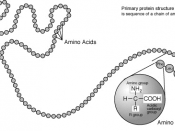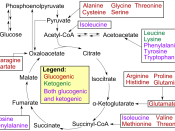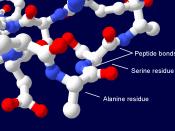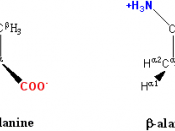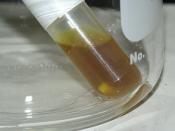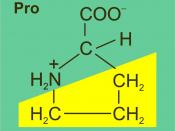Determining Amino Acids by Chromatographic Techniques By Big Jim The first step in determining the amino acid sequence of our peptide was to find the length of the peptide by a process called titration. Basically this process in tales pouring a certain amount of both phenolphthalein and formalin into a flask, then NaOH is added by an eyedropper until the solution turns a pale pink. You do this same procedure to three different flasks; however, a different chemical is added to each one. In one of them the formalin solution is added, to another add a certain amount of the unhydrolyzed peptide, and then in the last one add a certain amount of the hydrolyzed peptide solution. To all of these flasks more NaOH is add until the solutions turn pale pink and then the volume is recorded. These volumes are used to calculate the ratio of carboxylic groups from the hydrolyzed and unhydrolyzed peptide solutions.
This ratio tells the length of the peptide chain, and if the experiment is conducted correctly the length should be three, meaning that this is a tripeptide.
After we determined how long the peptide was we needed to find what amino acids that made up the peptide. To do this we used cellulose strips. We measured 1.5 cm from one end of the cellulose strip. This was where we would apply the amino acid that we wanted to test. We would apply a small drop using a capillary tube, dry it, then add another drop; this was repeated three times. After this was completed we placed the cellulose strips in a chromatography tube with .5 cm of solvent mixture with the application point closest to the mixture. Then the strip was left until the solvent mixture was allowed to reach within .5 cm of the top of the strip. They were then allowed to dry and then they were sprayed with ninhydrin solution. They again were allowed to dry. Then the distance from the application point to where the solvent stopped on the cellulose strip was measured and recorded. The distance from the center on the spot that formed and the point of application was also recorded. The second measurement mentioned in this paper was placed above the first measurement mentioned in this paper in a fraction. This determines the Rf value of the amino acid. This procedure was used for five amino acids: Phenylalanine, Arginine, Glycine, Proline, and Lysine. Later the same procedure was conducted with the tripeptide. Three different amino acids are found on the cellulose strip and then the Rf values of each were calculated. These Rf values were compared with the Rf values of the individual amino acids. The three Rf values that came the closest to the ones on the strip that was used for the tripeptide are the amino acids that are present in the tripeptide.
The three amino acids found in the tripeptide were Phenylalanie, Arginie, and Glycine. In different experiments it was determined that Phenylalanie was the N terminus and Arginie was the C terminus. This is shown in the structural formula below:
